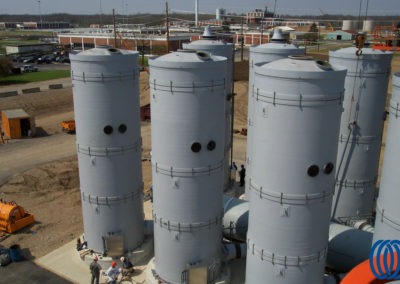
In a nutshell, there are essentially two different fabrication standards to pick from. Both are excellent when used in conjunction with the appropriate FRP asset. The purpose of this article is to differentiate the two and give you some general information to help you select the specification standard that best fits your situation.
ASTM (American Society for Testing & Materials) standards steer fabricators towards vessels that will perform well for a reasonable period of time, and are safe for their designed purposes. The most commonly used for FRP filament winding is D-3299 “Standard Specification for Filament-Wound Glass-Fiber-Reinforced Thermoset Resin Corrosion-Resistant Tanks”. ASTM describes D-3299 this way:
“This specification covers cylindrical corrosion-resistant tanks made of commercial-grade glass-fiber-reinforced polyester or vinyl ester thermoset resin fabricated by filament winding for above-ground vertical installation, to contain aggressive chemicals at atmospheric pressure as classified herein. This specification does not address the design of vessels intended for pressure above atmospheric, vacuum conditions, except as classified herein, or vessels intended for use with liquids heated above their flash points. Included are requirements for materials, properties, design, construction, dimensions, tolerances, workmanship, and appearance.”
“Special design consideration shall be given to tanks subject to environmental and/or mechanical forces such as seismic, wind, ice, agitation, or fluid dynamic forces, to operational service temperatures greater than 180°F (82°C) and to tanks with unsupported bottoms.”
ASTM standards also exist for other types of FRP fabrication, inspection and testing. Often, a basket of ASTM standards is needed to cover all areas of vessel design, fabrication and testing, and these standards must be selected by a qualified designer. For filament wound and contact molded shells, ASTM’s scope for pressure is limited to +/- 14″ w.c.
In contrast, ASME RTP-1 (American Society of Mechanical Engineers) is a more comprehensive standard that provides extensive documentation of the materials, design and fabrication methods, inspection, and shop qualification used in the fabrication of vessels. It’s requirements are more detailed and comprehensive. It covers pressures from full vacuum to 15psig and has wider scope than ASTM standards. Therefore vessels built to this standard have more requirements, cost more and have longer lead times to design and fabricate. Relatively few FRP fabricators in North America have attained the extensive and costly RTP-1 certification of their technicians and facilities.
ASME describes RTP-1 this specification this way:
“The Reinforced Thermoset Plastic (RTP) Corrosion-Resistant Equipment Certification Program applies to stationary vessels used for the storage, accumulation, or processing of corrosive or other substances at pressures not exceeding 15 psig external and/or 15 psig internal above any hydrostatic head. The RTP Certification Program requires fabrication done by hand lay-up but also allows for spray-up and filament wound methods of fabrication. ASME RTP certificates can also be extended to include field assembly and repair and field fabrication. The Certification Mark with an RTP Designator indicates that vessels bearing the Mark have been manufactured by a fabricator that has been certified by ASME and possesses a valid ASME RTP Certificate of Authorization.”
Both ASME and ASTM standards have their place; neither is “better” than the other. Selecting the appropriate standard just means your FRP assets will be built to the standards that best fit your situation.
For more information, please visit diamondfiberglass.com.

Recent Comments